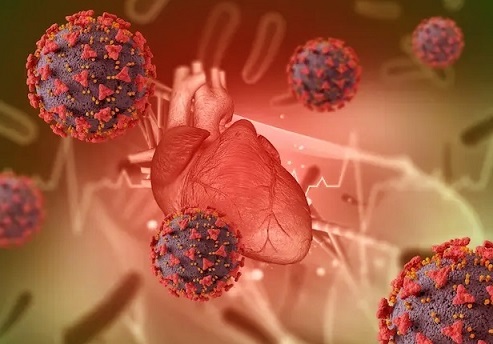Viruses including SARS-CoV-2 Silently Attack Heart Communication Proteins, Leading to Deadly Arrhythmias and Myocarditis
Nikhil Prasad Fact checked by:Thailand Medical News Team Mar 28, 2025 3 weeks, 5 days, 13 hours, 40 minutes ago
Medical News: Viruses Hijack Key Heart Communication Channels
A new study by researchers from the Fralin Biomedical Research Institute at Virginia Tech Carilion, the Virginia Tech Carilion School of Medicine, and other departments within Virginia Tech-USA has revealed a startling insight into how viruses attack the heart at a cellular level. The heart’s ability to beat regularly and contract properly depends on specialized proteins called connexins, which form tiny channels known as gap junctions. These channels allow heart cells to communicate with one another by exchanging electrical and chemical signals.
 Viruses including SARS-CoV-2 Silently Attack Heart Communication Proteins, Leading to
Viruses including SARS-CoV-2 Silently Attack Heart Communication Proteins, Leading to
Deadly Arrhythmias and Myocarditis
But during viral infections, this cellular communication system becomes a direct target. This
Medical News report uncovers how various viruses - from adenoviruses and coxsackieviruses to HIV and even SARS-CoV-2 - intentionally disrupt these connexin channels, setting the stage for dangerous heart rhythm problems and myocarditis, an often fatal inflammation of the heart muscle.
The Role of Connexins in the Beating Heart
Connexins, especially a variant known as connexin43 (Cx43), form the foundation of gap junctions that connect heart muscle cells. These connections ensure the synchronized contraction of the heart with every beat. When functioning properly, connexins facilitate not only electrical signaling but also the sharing of vital metabolic molecules and immune system messengers between cells.
Unfortunately, connexins are also highly sensitive to disturbances. They are short-lived and easily influenced by changes in their structure and cellular environment. This makes them vulnerable to viral manipulation.
How Viruses Exploit the Connexin System
The researchers found that multiple viruses have evolved complex strategies to sabotage connexin function in order to enhance their own survival and replication. For instance, adenoviruses induce specific chemical modifications - phosphorylations - on Cx43 proteins, rendering them dysfunctional. These viruses also lower the overall production of Cx43 and disrupt its position in the cell, creating an environment prone to heart rhythm disturbances.
Coxsackievirus B3 (CVB3), another common cause of viral myocarditis, was shown to reduce the expression of not just Cx43 but also Cx45, another crucial heart connexin. The virus increases certain microRNAs like miR-1 and miR-19b, which block the production of these proteins. Additionally, CVB3 damages structural proteins in the heart, such as dystrophin, leading to further misplacement of connexins within heart cells.
HIV and SARS-CoV-2 Join the Attack
HIV infection was also linked to increased Cx43 expression - but not in a good way. Instead of aiding heart function, this overexpression was accompanied by Cx43 moving to the wrong parts of the cell. This misplacement led to increased cell dama
ge, inflammation, and fibrosis. In HIV patients, these changes may be responsible for some of the observed cardiac complications.
SARS-CoV-2, the virus behind COVID-19, was found to interfere with Cx43 in a different way. Its spike protein causes the Cx43 protein to relocate away from its usual position, impairing its ability to support cell-to-cell communication. Furthermore, the spike protein activates Cx43 hemichannels - structures that, when opened uncontrollably, can leak harmful signals and damage surrounding heart cells.
Connexins Play a Role in Immune Response Too
Gap junctions are more than just electrical connectors. They also serve an immune role by helping cells share signals that fight off viruses. Some immune messengers like cGAMP and viral antigens can pass through connexins to alert neighboring cells and mount a collective antiviral defense. But when viruses disrupt this system, they not only avoid detection but also use the disrupted gap junctions to spread toxic molecules and increase the damage.
Inflammation Makes It Worse
Inflammatory substances released during infection further aggravate the damage. Cytokines like TNF-α and IL-1β, which are common in viral myocarditis, were shown to impair heart cell function and decrease connexin production. These inflammatory agents cause changes in the structure of Cx43, making the gap junctions less functional and leading to increased risk of arrhythmias.
Therapeutic Challenges and Hopes
Despite understanding these dangerous effects, current treatments for viral myocarditis remain limited. Some anti-inflammatory drugs like anakinra (an IL-1 blocker) have shown promise, but larger clinical trials are needed. Future therapies may focus on stopping the specific viral actions that alter connexins or finding ways to restore normal connexin function without disrupting their immune roles.
However, targeting pathways like protein kinase C (PKC) - a molecule involved in many of the observed changes to connexins - is tricky because of its wide presence in the body and lack of specific inhibitors.
Conclusions
The study sheds light on how viruses cleverly subvert a vital component of heart health - connexins - to weaken the heart’s structure, disrupt its rhythm, and disable immune defenses. By damaging these gap junctions, viruses create the perfect storm for arrhythmias and myocarditis to develop. These findings underscore the importance of researching both the direct viral attacks and the secondary effects of inflammation on heart connexins. Understanding this double-hit strategy will be critical in developing effective treatments for viral heart diseases and in preventing long-term cardiac damage in patients with infections like COVID-19 or HIV.
The study findings were published in the peer reviewed journal: Current Cardiology Reports
https://link.springer.com/article/10.1007/s11886-025-02227-6
For the latest on Cardiology, keep on logging to Thailand
Medical News.
Read Also:
https://www.thailandmedical.news/news/american-study-discovers-that-covid-19-alters-heart-glycosylation-leading-to-potential-cardiac-complications
https://www.thailandmedical.news/news/taiwanese-study-reveals-heart-health-benefits-of-the-phytochemical-momordicine-i-from-bitter-melon
https://www.thailandmedical.news/news/breaking-university-of-queensland-study-discovers-that-sars-cov-2-actually-attacks-the-dna-of-heart-cells
https://www.thailandmedical.news/pages/thailand_doctors_listings
https://www.thailandmedical.news/articles/hospital-news
Follow us on:
https://x.com/ThailandMedicaX
https://www.facebook.com/ThailandMedicalNews
https://bsky.app/profile/thailandmedical.bsky.social
https://gettr.com/user/thailandmedicalnews
https://www.tribel.com/thailandmedical/wall
and 33 other social media platforms
